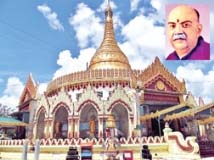By Dr Anirban Ganguly
On a recent visit to Myanmar now called Burma as part of a delegation to participate in a dialogue on India-Myanmar relations, I was invariably reminded of the great impact Dr Syama Prasad Mookerjee had once made on the national psyche of that country. It was through this visit that we rediscovered his footsteps that had carried India’s civilisational message to this land and its people as a light of solace and strength.
In a book I wrote last year on the intellectual underpinnings of the nationalist-cultural debate in India, I had dedicated an entire chapter to Dr Mookerjee’s contribution not only to the study of Indian culture but also referred to his efforts in trying to re-forge and re-invent India’s civilisational link with her Southeast Asian neighbours. Dr Mookerjee, as President of the Mahabodhi Society of India, played a crucial role in trying to re-lay cultural, spiritual, civilisational bridge. This visit enabled us to see for ourselves the result of Dr Mookerjee’s efforts, though perhaps forgotten in his own country and in Myanmar, they reflect the self-less spirit of the leader whose only aim was to strengthen of the bond between two historically close civilisational partners.
Dr Mookerjee, it is little known, was instrumental in India gifting as a ‘permanent loan’, the sacred relics of Buddha’s two chief disciples, Sariputta and Moggallana, to the people of Myanmar. In early 1950 he had arranged for these relics to be flown to Myanmar and then taken across the country. The gesture had made a deep impact among the people and the legendary Prime Minister of Myanmar, U Nu, had requested Dr Mookerjee to make efforts to lend a portion to Myanmar. Through deft and indefatigable effort Dr Mookerjee succeeded in acceding to this request. He wrote to Prime Minister Nehru that the ‘Prime Minister of Burma’ was ‘anxious that a small portion of the relics may be kept in Burma’ and that ‘this will have a unifying influence on the people of Burma and will also establish good feelings between India and Burma.”
To the then Secretary of the Ministry of External Affairs, Subimal Dutta, Dr Mookerjee explained his reasons for trying to push this through, ‘by allowing portions of the relics to be kept in Burma, we will be forging another close link between India and Burma in religious and cultural spheres, which, I have no doubt, will have good effect on Indo-Burmese relationship generally.’ His one-pointed efforts yielded results and sacred relics were given as ‘permanent loans’ to the people of Myanmar. To U Nu, he wrote, that he had ‘every hope that this will strengthen further the bonds of union between India and Burma and bring peace and contentment to people of your great country.’ In a touching letter, U Nu expressed gratitude to Dr Mookerjee’s grand gesture, ‘on behalf of the government and the people of Burma’ and expressed his confidence that this ‘noble and generous gift of some portions of the sacred relics of the arahants Sariputta and Moggallana for permanent enshrinement in Burma would further cement the already very close and unique relationship between our two sister countries. The whole of the Buddhist world, I am sure, would join me in saying “sadhu!, sadhu!, sadhu!” for the noble gesture and meritorious deed your good-self and the Mahabodhi Society of India.’
The sacred relics were finally enshrined in the Kaba Aye (World Peace) Pagoda, then in the outskirts of Yangon, in early March 1952. Dr Mookerjee was a specially invited guest on the occasion. It perhaps is the right time to rediscover that link, that cementing tie and that binding gesture – at a subliminal level, it is this link that remains constant and perennial and can be looked for whenever the ties between the two sister countries need to be re-layed and re-stated.
As I entered the precincts of the Kaba Aya Pagoda, in the footsteps of Dr Mookerjee, and looked around at the surroundings that he must have seen and inhaled, I could almost hear the faint echoes of that cry of gratitude, ‘sadhu, sadhu, sadhu’ – a cry that perhaps remains the key to a new partnership towards a new horizon.
(The writer is the Director of Dr Syama Prasad Mookerjee Research Foundation, New Delhi)


